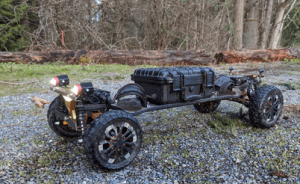Electric skateboards are an innovative way to explore your neighborhood or commute to work or school. With speeds up to 20 mph, they can make traveling more convenient and fun. However, learning to ride an electric skateboard responsibly takes patience and practice. This guide will cover the basics of electric skateboards, safety tips, and how to master the ride.

What is an Electric Skateboard?
An electric skateboard consists of a deck similar to a regular skateboard, along with an electric motor, battery, remote control, and wheels. The key components are an electric motor attached to the deck, which provides the power. A lithium-ion battery pack supplies the motor with power, a remote control to operate the acceleration, braking, and cruise control, and finally, polyurethane wheels with ball bearings. Based on these components, electric skateboards typically come in two types – longboards for cruising and skateboards for tricks and maneuvers. The longboards offer speeds up to 25 mph, while skateboards usually have a max speed of around 18 mph, depending on the motor wattage.
Safety Tips for Riding an Electric Skateboard
The first thing is to always wear a helmet, knee pads, elbow pads, and wrist guards. These are essential protective gear for avoiding serious injuries while riding an electric skateboard. Next, when first learning to ride an electric skateboard, start off slow at the lowest speed setting to gain confidence and stability. As you become more comfortable, gradually increase the speed in smaller increments. Finally, be aware of your surroundings at all times – look out for pedestrians, cars, obstacles, and uneven terrain. Remain alert to changes in the road or people entering your path so you can slow down or maneuver appropriately to avoid accidents. Always ride defensively and cautiously until riding becomes second nature.
Learning How to Ride

The first step is to familiarize yourself with the board’s remote control. Place your feet on the board but remain stationary. Practice accelerating to the lowest speed setting and braking to a complete stop to get a feel for the controls. Once comfortable with the remote, position both feet around the front bolts and practice balancing with both knees slightly bent. As balance improves, learn how to turn by shifting your weight and leaning in the direction you want to go. For braking, use both the remote brake and foot braking by dragging your heel along the ground. Start with gradual foot brakes and work up to quicker braking as your confidence grows. Only attempt slow-speed turns and stop gradually at first until you develop muscle memory for operating the electric skateboard. With practice and repetition, the riding techniques will become more natural and refined.
Common Issues and Solutions
Many common issues arise with electric skateboards, but most have straightforward solutions. Loose screws or bolts in the trucks, motor, or wheels can cause rattling and instability, so check all hardware regularly and tighten as needed. Loose wires connecting components may cause intermittent power or signal loss, so inspect wire connections and reseat or replace damaged wiring. Faulty remote controls are also a possibility, which may require recalibration or replacement. Another common issue is short battery life or inability to charge, indicating a battery or charger fault. This often requires replacing the battery pack. Many electronic speed controllers can also fail over time, affecting acceleration and braking, in which case these may need to be recalibrated or replaced. Fortunately, most parts for e-skateboards are modular and replaceable relatively easily, allowing owners to fix or upgrade components with minimal hassle.
FAQs
How fast can electric skateboards go?
It depends on the model but most travel between 10-20 mph. Some high-performance boards can reach up to 30 mph.
How far can electric skateboards travel on one charge?
Range varies from 5 to 25 miles depending on the battery capacity and rider’s weight.
Are electric skateboards legal?
Laws vary by location, but most places do allow electric skateboards with restrictions like helmet requirements and speed limits.
What is the weight limit for electric skateboards?
Most standard boards can support riders up to 220 lbs. Heavier duty models support weights from 220-350 lbs.
How much do electric skateboards cost?
Prices typically range from $300 to $2,500 or more, depending on the size, speed, battery power, and brand.
Read More
- Expert Guide For Choosing An Electric Longboard Skateboard In 2023 – Ecomobl
- Electric Skateboard Weight Limit – Ecomobl
- Shopping Guide Of Skateboard With Remote Control – Ecomobl
- Electric Skateboard Wet Riding Maintenance – Ecomobl
- Exploring The Off Road Capabilities Of Electric Mountain Boards – Ecomobl

